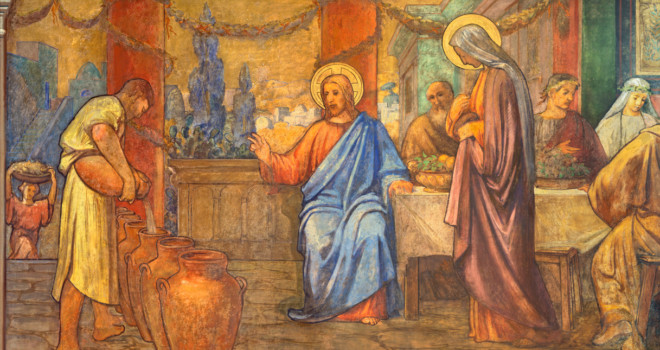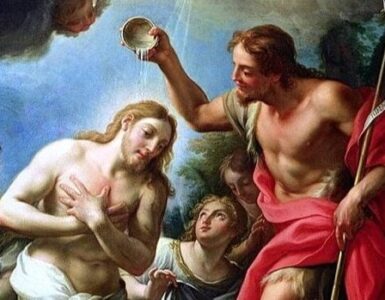In the Gospel of John, the stories that involve Mary the mother of Jesus contain an oddity that baffles many readers. Mary appears only twice in this Gospel, in the wedding at Cana and at the foot of the cross, and both times Jesus addresses her in a seemingly rude way. Instead of calling her “mother,” “mom,” or some ancient Jewish equivalent, he simply calls her “woman” (John 2:4, 19:26). That sounded just as weird in the first century as it does today, so it cries out for an explanation. It invites us to look below the surface and search for a deeper meaning, one that can enrich our spiritual lives and help us to better understand Mary’s place in the Catholic faith.
In the Beginning
Let’s begin with the first instance of this strange address,
the wedding at Cana. To properly understand this narrative, we have to go back
to the very beginning of John’s Gospel. It starts out in a way that is very
reminiscent of the seven-day creation story in Genesis:
“In the beginning was the Word…all things were made through him, and without him was not anything made that was made.” (John 1:1, 3)
That opening phrase should sound familiar to anyone with
even a passing familiarity with Scripture. The first three words are taken
verbatim from the very first line of Genesis, “In the beginning God created the
heavens and the earth” (Genesis 1:1), and the mention of creation two verses
later continues this allusion.
New Creation Week
Moreover, if we read the next two chapters carefully, we see
that John connects the beginning of his Gospel to this creation story in
another, subtler way as well: he narrates a succession of seven days,
paralleling the seven days of creation in the first chapter of Genesis. While
he never explicitly tells us he is doing this, he tips us off by marking the
days that pass in his account. After he recounts John the Baptist’s testimony
about his identity, he says that the next story happened “the next day” (John
1:29), and he does this two more times (John 1:35, 43).
If we consider everything before the first instance of the
phrase “the next day” to be the first day, the three that follow get us to day
number four. Then, the very next story happens “on the third day,” which gets
us to day number seven. Finally, on the seventh day we have the story of the
wedding at Cana, which calls to mind the first married couple, Adam and Eve
(Genesis 2:21-25), the only human characters in the creation stories in
Genesis.
The New Eve
With all these points of contact with the Old Testament’s
stories of the world’s creation, John is subtly telling us that Jesus’ ministry
inaugurated the new creation, the restoration of everything that Adam and Eve
messed up by eating from the forbidden tree. Moreover, while the final story in
his new creation week takes place at a wedding, John never says who the bride
and groom are. Instead, the only characters whose identities we know are Jesus
and his mother, and that is highly significant.
Since the wedding setting calls to mind Adam and Eve, the
world’s first married couple, this mysterious lack of any other identifiable
characters tells us that Jesus and Mary are themselves the new Adam and Eve of
this new creation. Jesus is the head of the new humanity, just as Adam was the
head of the old, sinful humanity (Romans 5:12-19; 1 Corinthians 15:22, 45), and
just as Eve played a key role in our Fall by eating the forbidden fruit and
then giving it to Adam, so too did Mary play a key role in our redemption by
giving birth to our savior and by prompting him to perform his first miracle
and thus begin his public ministry (John 2:11).
Once we realize this, we can understand why Jesus calls his
mother “woman” in this story. In the creation accounts, Eve is called “woman”
more often than she is called “Eve” (for example, Genesis 2:22-23), so in the
wedding at Cana, the name clearly harkens back to her. By calling his mother
“woman,” Jesus is confirming for us that she really is the new Eve, his
counterpart as the new Adam.
The Foot of the Cross
And we find similar connections at the foot of the cross,
the second time Jesus addresses his mother this way (John 19:25-26). The key
here is that elsewhere in John, Jesus describes his death on the cross as the
moment of the devil’s defeat (John 12:31-33). Now, at first that may not seem
to have much to do with Eve or the creation stories, but let’s dig a bit
deeper. After Adam and Eve committed the world’s first sin, God turned to them
and punished them, but before he did that, he pronounced a curse on the snake
that had tempted them (which was the devil, as Revelation 12:9 tells us):
“I will put enmity between you and the woman,
and between your seed and her seed;
he shall bruise your head,
and you shall bruise his heel.”(Genesis 3:15)
God promised that the snake would fight against the seed of
the “woman,” and while the text does not explicitly say who will win, it
implies that the woman’s seed will be the victor. For one, the fact that it is
a curse on the snake rather than on Adam and Eve implies that the snake will
get the worst of it, and secondly, strikes to the head are usually much worse
than strikes on the heel. In fact, strikes to the head are often fatal, so the
implication is that the snake is going to die. Granted, the devil can’t literally
die, so it just means that he is going to be definitively defeated by the seed
of the “woman.”
And who is this promised seed? It is Jesus; he is the one
who defeated the devil and redeemed the human race. Now, as he himself explains
in John’s Gospel, this defeat happened on the cross, so right when he fulfilled
the prophecy about the seed of the “woman” who would defeat the devil, he
called his mother “woman.” Jesus knew the Old Testament extremely well, so this
was not a coincidence. No, it was an intentional allusion to the snake’s
punishment back in Genesis. Just as Jesus is the promised “seed,” so too is
Mary the new Eve, the new “woman” whose son defeated Satan and all his minions.
Our Spiritual Mother
With that, we can see that both times when Jesus calls Mary
“woman” in the Gospel of John he is alluding to Eve, the first woman ever
created. He addresses his mother this way in order to subtly teach us that just
as he is the new Adam, so too is she the new Eve.
And that is extremely significant for our spiritual lives. It is one of the key reasons why we Catholics love Mary so much. Just as Eve is the physical mother of the entire human race (Genesis 3:20), so too is Mary the spiritual mother of all those who’ve been renewed by the grace Jesus won for us on the cross. As a result, while it may at first seem weird for Jesus to call his mother “woman,” it actually contains a great depth of meaning. It teaches us that Mary is not just a random person who lived 2,000 years ago. No, she is our mother, so she is still very important for us today.
✠












